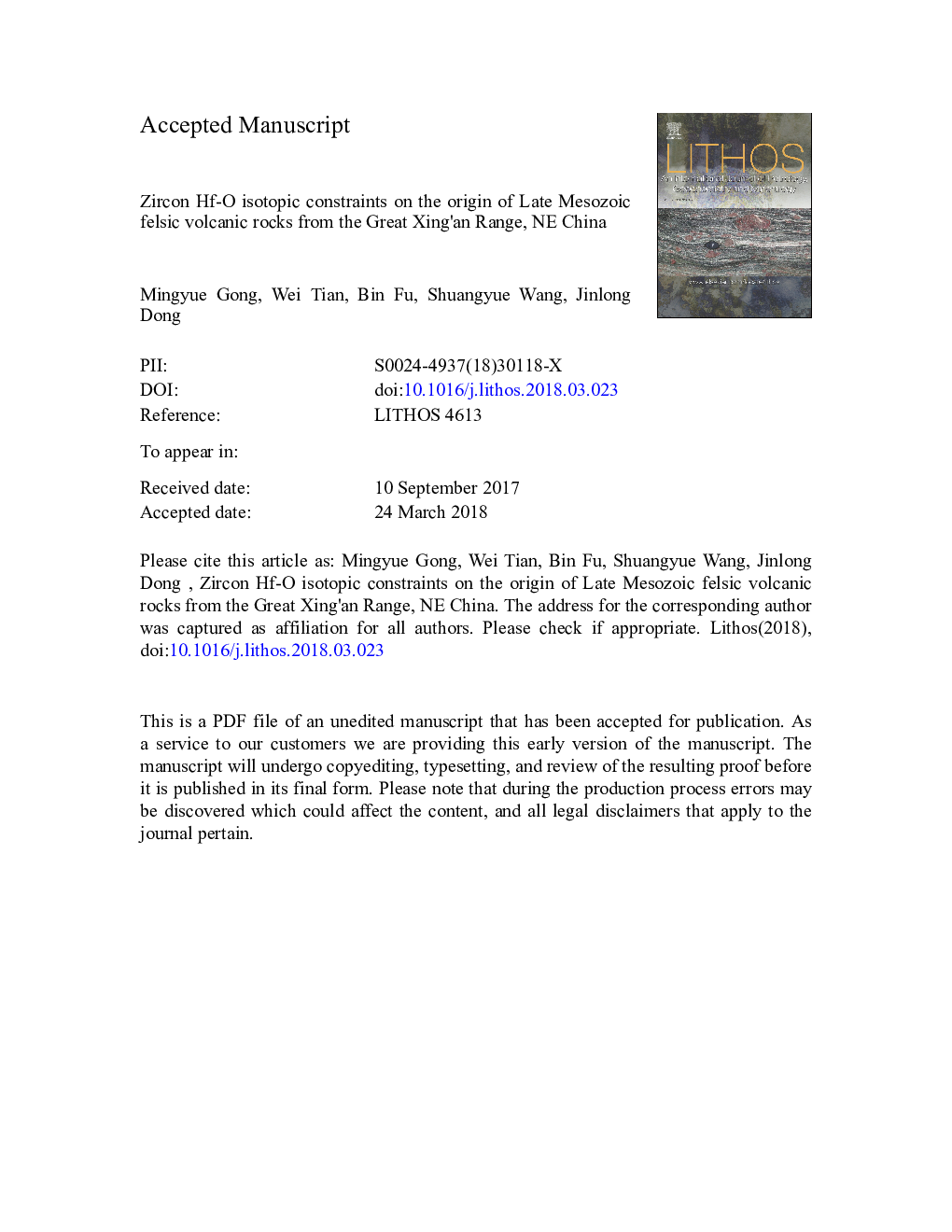| کد مقاله | کد نشریه | سال انتشار | مقاله انگلیسی | نسخه تمام متن |
|---|---|---|---|---|
| 8911663 | 1638620 | 2018 | 62 صفحه PDF | دانلود رایگان |
عنوان انگلیسی مقاله ISI
Zircon Hf-O isotopic constraints on the origin of Late Mesozoic felsic volcanic rocks from the Great Xing'an Range, NE China
دانلود مقاله + سفارش ترجمه
دانلود مقاله ISI انگلیسی
رایگان برای ایرانیان
موضوعات مرتبط
مهندسی و علوم پایه
علوم زمین و سیارات
ژئوشیمی و پترولوژی
پیش نمایش صفحه اول مقاله

چکیده انگلیسی
The voluminous Late Mesozoic magmatism was related to extensive re-melting of juvenile materials that were added to the Central East Asia continent in Phanerozoic time. The most favoured magma generation mechanism of Late Mesozoic magmas is partial melting of underplated lower crust that had radiogenic Hf-Nd isotopic characteristics, but this mechanism faces difficulties when interpreting other isotopic data. The tectonic environment controlling the generation of the Late Mesozoic felsic magmas is also in dispute. In this study, we obtained new U-Pb ages, and geochemical and isotopic data of representative Jurassic (154.4â¯Â±â¯1.5â¯Ma) and Cretaceous (140.2â¯Â±â¯1.5â¯Ma) felsic volcanic samples. The Jurassic sample has inherited zircon cores of Permian age, with depleted mantle-like εHf(t) of +7.4â¯ââ¯+8.5, which is in contrast with those of the magmatic zircons (εHf(t)â¯=â¯+2.4â¯Â±â¯0.7). Whereas the inherited cores and the magmatic zircons have identical mantle-like δ18O composition ranges (4.25-5.29â° and 4.69-5.54â°, respectively). These Hf-O isotopic characteristics suggest a mixed source of enriched mantle materials rather than ancient crustal components and a depleted mantle source represented by the inherited Permian zircon core. This mechanism is manifested by the eruption of Jurassic alkaline basalts originated from an enriched mantle source. The Cretaceous sample has high εHf(t) of +7.0â¯ââ¯+10.5, suggesting re-melting of a mafic magma derived from a depleted mantle-source. However, the sub-mantle zircon δ18O values (3.70-4.58â°) suggest the depleted mantle-derived mafic source rocks had experienced high temperature hydrothermal alteration at upper crustal level. Therefore, the Cretaceous felsic magma, if not all, could be generated by re-melting of down-dropped supracrustal volcanic rocks that experienced high temperature oxygen isotope alteration. The two processes, enriched mantle-contribution and supracrustal juvenile material re-melting, are new generation mechanisms of the Late Mesozoic magmas from Central East Asia. Rift settings may have controlled these processes throughout crustal and mantle levels.
ناشر
Database: Elsevier - ScienceDirect (ساینس دایرکت)
Journal: Lithos - Volumes 308â309, May 2018, Pages 412-427
Journal: Lithos - Volumes 308â309, May 2018, Pages 412-427
نویسندگان
Mingyue Gong, Wei Tian, Bin Fu, Shuangyue Wang, Jinlong Dong,